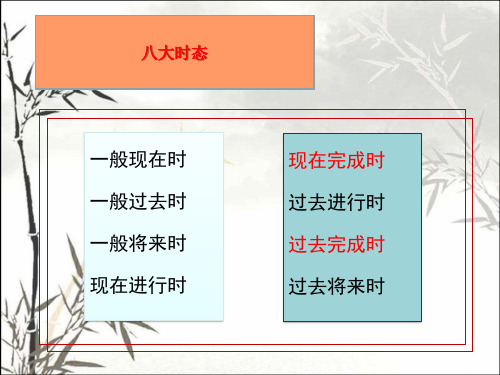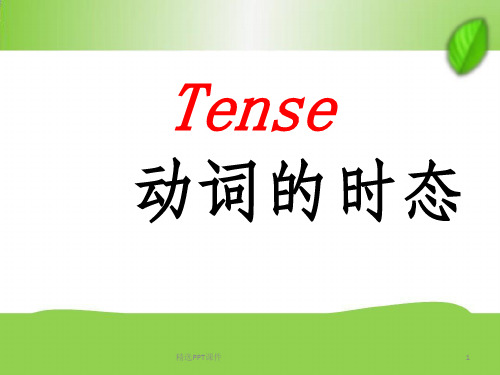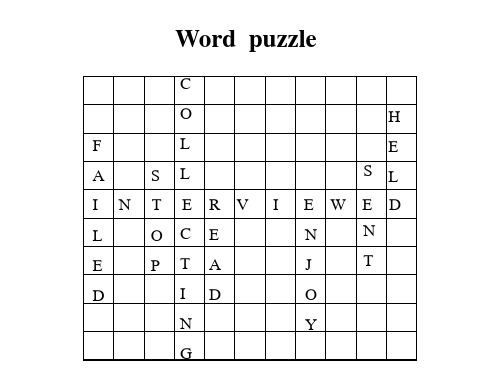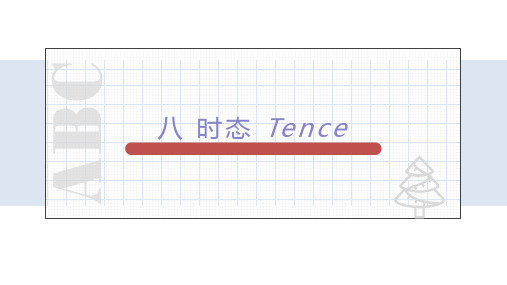初中英语八大时态复习课件(共48张PPT)
合集下载
八大时态 PPT课件

八大时态
一般现在时 一般过去时
现在完成时
过去进行时 过去完成时 过去将来时
一般将来时
现在进行时
一般现在时
表示经常性或习惯性的动作
表示现在的状态
表示普遍事实或真理
一般现在时结构
当主语不是第三人称单数时: 肯定句 :主语+动词原形+其它 否定句 :主语+don't+动词原形+其它 一般疑问句: Do+主语+动词原形+其它
I leave home for school at 7:00 every morning. She/He/It gets up at 6:00 every day.
一般过去时
表示过去某个时间发生的动作或存在的状态,长和表 示过去的时间状语连用 例如:yesterday,last night,in+过去的年份, two days ago,before,the age of,the day before yesterday等。 也表示过去经常或反复发生的动作,长和表示频度的 时间状语连用 例如:often,always,once a week
2)This is the… that…结构,that从句要用现在完成时. This is the best film that I've (ever) seen. 这是我看过的最好的电影。 This is the first time (that) I've heard him sing. 这是我第一次听他唱歌。
用于现在完成时的句型
1)It is the first / second time…. that…结构中的从句部分,用现在完 成时。 It is the first time that I have visited the city. It was the third time that the boy had been late.
一般现在时 一般过去时
现在完成时
过去进行时 过去完成时 过去将来时
一般将来时
现在进行时
一般现在时
表示经常性或习惯性的动作
表示现在的状态
表示普遍事实或真理
一般现在时结构
当主语不是第三人称单数时: 肯定句 :主语+动词原形+其它 否定句 :主语+don't+动词原形+其它 一般疑问句: Do+主语+动词原形+其它
I leave home for school at 7:00 every morning. She/He/It gets up at 6:00 every day.
一般过去时
表示过去某个时间发生的动作或存在的状态,长和表 示过去的时间状语连用 例如:yesterday,last night,in+过去的年份, two days ago,before,the age of,the day before yesterday等。 也表示过去经常或反复发生的动作,长和表示频度的 时间状语连用 例如:often,always,once a week
2)This is the… that…结构,that从句要用现在完成时. This is the best film that I've (ever) seen. 这是我看过的最好的电影。 This is the first time (that) I've heard him sing. 这是我第一次听他唱歌。
用于现在完成时的句型
1)It is the first / second time…. that…结构中的从句部分,用现在完 成时。 It is the first time that I have visited the city. It was the third time that the boy had been late.
初中英语八大时态-讲解ppt课件

例题
Li Ming didn’t understand what American people
said,_____?
A.couldn’t he
B.could he
C.didn’t he
精选PPT课件 D.did he
8
三、现在进行时
1.用法:
A.现刻动作:目前正在发生的动作。
B.现阶段动作:目前一个时期一直在进行的 动作,此刻不一定在进行。
I have worked.
I had worked.
精选PPT课件
5
•各种时态的用法
精选PPT课件
6
一、一般现在时
1.用法:A.现在经常性的动作或状态 B.客观事实和真理。
2.标志词:always, usually,often, sometimes, never, every day /week /month/year/…
例句:I am working.
例句:I was working.
精选PPT课件
3
一般将来时, 将 will加原型。 来 过去将来时,
would加原型。
I will work.
I would work.
精选PPT课件
4
完 成
现在完成时, have/has加过分。 过去完成时,
时 had 加过分。
tomorrow,in three days,in (the)
future,next week/month/term…,
from now on 精选PPT课件
14
4.shall/will/be going to之间的区别:
shall往往用于第一人称疑问句, will可用于任何人称。
八大时态讲解(共26张PPT)

He is going to buy her some flowers.
0 一般过去将来时:
He was sixty-eight. In two years he would be seventy.
I knew you would agree.
0 现在英进行语时的: 动词时态(进行) What are you doing?
算;
如:I am going to listen to music. (我打算听音乐) will /shall 表示未事先思考或为计划过的意图
如:It will be Christmas soon .(很快就圣诞节了)
4. 现在进行时态( The Present Continuous Tense )
5、我们离开广州六年了。
We have left Guangzhou for 6 years . ×
We have been away from Guangzhou for 6
years .
3.常见句型
1) 主句(现在完成时)+since 从句(一般过去时).
2) It is +一段时间+ since 从句(一般过去时).
has gone to
He said had seen this morning, …ago, etc
that he _________the film many 如果明天不下雨,我们将去野营。
He has borrowed the pen for three days .
times. 现在进行时态( The Present Continuous Tense )
was /were going to +动词原形
0 一般过去将来时:
He was sixty-eight. In two years he would be seventy.
I knew you would agree.
0 现在英进行语时的: 动词时态(进行) What are you doing?
算;
如:I am going to listen to music. (我打算听音乐) will /shall 表示未事先思考或为计划过的意图
如:It will be Christmas soon .(很快就圣诞节了)
4. 现在进行时态( The Present Continuous Tense )
5、我们离开广州六年了。
We have left Guangzhou for 6 years . ×
We have been away from Guangzhou for 6
years .
3.常见句型
1) 主句(现在完成时)+since 从句(一般过去时).
2) It is +一段时间+ since 从句(一般过去时).
has gone to
He said had seen this morning, …ago, etc
that he _________the film many 如果明天不下雨,我们将去野营。
He has borrowed the pen for three days .
times. 现在进行时态( The Present Continuous Tense )
was /were going to +动词原形
初中英语八大时态课件

典型例句
I have just finished my homework. 我刚刚完成了 我的作业。
She hasn’t seen the film yet. 她还没有看过这部电影 。
Have you ever been to Europe? 你曾经去过欧洲吗 ?
They haven’t had any success so far. 他们到目前 为止还没有任何成功。
典型例句
总结词:用来说明一般过去时的用法和形式。
详细描述:以下是一些典型例句,说明一般过 去时的用法和形式
I played tennis yesterday.(我昨天打网球了。)
They visited the museum last week.(他们 上周参观了博物馆。)
We went to the party last night.(我们昨晚 参加了聚会。)
用法
主要用于描述现在正在发生的事情,也可以用于描述最近一段时间内发生的事情 ,强调现在的情况或状态。
动词形式
基本形式
be动词+动词的现在分词
肯定式
am/is/are+动词的现在分词
否定式
am/is/are+not+动词的现在分词
疑问式
把be动词提前到句首,其他部分按 顺序排列
典型例句
I am studying English now.(我现在正在学习英 语。)
总结词
表示过去发生的动作对现在产生的影响或结果
详细描述
现在完成时是指动作发生在过去,但这个动作对现在产生了 一定的影响或结果。这个时态常与“已经”、“刚刚”等词 连用,强调的是现在的情况或结果。
动词形式
英语八大时态PPT课件(详细版)

come)
The perfect tense is formed by combining the presentation
particles of the verb with have or has (e.g., he has gone, she has come)
The Composition of the Eight Tenses in English
03
Examples
I have studied, They have played, He has written
Present simple tense
Definition
The present simple tense is used to express an action that is verbal, generic, or not emphasizing time
VS
Tense can be classified into two categories: simple tense and complex tense Simple tense includes present, past, and future tense, while complex tense includes the perfect, the superior, the future perfect, and the conditional perfect tense
Conditional Perfect Tense
It is used to express actions or events that would have been completed in the past if a condition had been met
The perfect tense is formed by combining the presentation
particles of the verb with have or has (e.g., he has gone, she has come)
The Composition of the Eight Tenses in English
03
Examples
I have studied, They have played, He has written
Present simple tense
Definition
The present simple tense is used to express an action that is verbal, generic, or not emphasizing time
VS
Tense can be classified into two categories: simple tense and complex tense Simple tense includes present, past, and future tense, while complex tense includes the perfect, the superior, the future perfect, and the conditional perfect tense
Conditional Perfect Tense
It is used to express actions or events that would have been completed in the past if a condition had been met
初中英语八大时态课件

练习:请用现在完成进行时完 成以下句子
1. He ___________ (work) in this company for two years.
04
2. We ___________ (know) each other for a long time.
08
时态七:过去完成时
定义与用法
过去完成时表示在过去某一时间之前已经完成的动作或状态 。常与 "before" 或 "by" 等引导的时间状语连用。
定义
过去将来时表示在过去某个时间点,对将来某个时间的预测 或期望。
用法
常用于描述过去某个事件的后果或对将来某个事件的预测, 也可用于表达过去的习惯或常规。
ቤተ መጻሕፍቲ ባይዱ词形式
基本形式
would + 动词原形
过去完成时形式
had + 过去分词
举例与练习
举例:He said he would come to my party tomorrow.( 他说他明天会来参加 我的聚会
用法:过去完成时描述的是过去的过去发生的动作或状态, 即“过去的过去”。
动词形式
基本形式
had + 过去分词
注意
过去完成时的动词形式是在助动词 “had” 之后加上过去分词。
举例与练习
例句:I had finished my homework before dinner.(我在晚饭前已经完成了作业。)
练习:Please answer the following questions in English.(请用英语回答以下问题。)
2. When are you going to finish your homework?(你什么时候完成你的作业?)
初中英语八种时态归纳PPT

10. About 400 years ago, Galileo proved that the earth travels (travel) around the sun.
Part B 语态
Active Voice
Passive Voice
主动语态
1. Many people speak English.
At the party.
--- I _l_ik_e___ your jacket, Tim. How long _h_a_v_e_y_o_u__h_a_d__ it?
Oh…er… I __b_o_u_g_h_t__it last week. W__o_u_l_d_y_o_u__li_k_e_ to dance, Becky? ---Phew. It’s __h_o_t__ here. --- Put your jacket on the chair. You ____n_e_e_d_n’wt orry. It’ll be ok. ---That’s _b_e_tt_e_r __.
8. Mr. Green and his wife had lived (live) in London for a few years before they came (come) to work in China in 2001.
9. He said he w__o_u_ld__n_o_t_s_p_e_a(k not,speak) at the meeting the next day.
4. Hurry! Your classmates _a_r_e_w__a_it_i_n_g(wait) for you in the classroom..
1. This is the third time you _h_a_v_e__b_e_e_n__(be) here.
Part B 语态
Active Voice
Passive Voice
主动语态
1. Many people speak English.
At the party.
--- I _l_ik_e___ your jacket, Tim. How long _h_a_v_e_y_o_u__h_a_d__ it?
Oh…er… I __b_o_u_g_h_t__it last week. W__o_u_l_d_y_o_u__li_k_e_ to dance, Becky? ---Phew. It’s __h_o_t__ here. --- Put your jacket on the chair. You ____n_e_e_d_n’wt orry. It’ll be ok. ---That’s _b_e_tt_e_r __.
8. Mr. Green and his wife had lived (live) in London for a few years before they came (come) to work in China in 2001.
9. He said he w__o_u_ld__n_o_t_s_p_e_a(k not,speak) at the meeting the next day.
4. Hurry! Your classmates _a_r_e_w__a_it_i_n_g(wait) for you in the classroom..
1. This is the third time you _h_a_v_e__b_e_e_n__(be) here.
初中英语八大时态课件(共77张PPT)

exercise
把下列句子改为一般疑问句
1.He has a meeting on Sundays . Does he have a meeting on Sundays ?
2.He goes to school at seven in the morning . Does he go to school at seven in the morning?
2. 当 主 语 是 单 数 第 三 人 称 时 , 它与助动词Does有关,但是 动词谓语一定要恢复为原形。 当主语是其他人称时,它与 助动词Do有关。
I like English. She likes it very much. We go to work by bike.
否定句
I don’t like English.
3.My father and mother go out for lunch on Sundays. Do your father and mother go out for lunch on Sundays ?
4.We do our homework after school.
Do you do your homework after school ?
2) I will return home as soon as I finish my task.
2、be going to + v原形
①表示打算做某事 ②表示现在已经有迹象表明将要发生某事。
--- What __a_re__y_o_u__g_o_in_g__t_o_do this evening? --- I am going to do my lessons.
Review of Tenses
英语时态8种基本时态讲解ppt课件

• c)----He joined the army in 1990. • -----He didn’t joined the army in 1990. • -----Did he join the army in 1990? • -----Yes ,he did ./No ,he didn’t.
认识到了贫困户贫困的根本原因,才 能开始 对症下 药,然 后药到 病除。 近年来 国家对 扶贫工 作高度 重视, 已经展 开了“ 精准扶 贫”项 目
4.过去将来时
• 过去将来时是立足于过去某时,从 过去的观点看将要发生的动作或状 态。主要用于宾语从句中。
认识到了贫困户贫困的根本原因,才 能开始 对症下 药,然 后药到 病除。 近年来 国家对 扶贫工 作高度 重视, 已经展 开了“ 精准扶 贫”项 目
• c)以辅音字母+y结尾的单词变y为i加 -es.
• Study---studies carry-carries • d)以元音字母+y结尾的单词直接加-s. • play---plays stay---stays
• 句型结构:主语+will/shall+V.原形 +…(第一人称用shall)
• I shall go to Shanghai tomorrow. • They will have a meeting next week. • ----She will be 20 years old.
认识到了贫困户贫困的根本原因,才 能开始 对症下 药,然 后药到 病除。 近年来 国家对 扶贫工 作高度 重视, 已经展 开了“ 精准扶 贫”项 目
认识到了贫困户贫困的根本原因,才 能开始 对症下 药,然 后药到 病除。 近年来 国家对 扶贫工 作高度 重视, 已经展 开了“ 精准扶 贫”项 目
认识到了贫困户贫困的根本原因,才 能开始 对症下 药,然 后药到 病除。 近年来 国家对 扶贫工 作高度 重视, 已经展 开了“ 精准扶 贫”项 目
4.过去将来时
• 过去将来时是立足于过去某时,从 过去的观点看将要发生的动作或状 态。主要用于宾语从句中。
认识到了贫困户贫困的根本原因,才 能开始 对症下 药,然 后药到 病除。 近年来 国家对 扶贫工 作高度 重视, 已经展 开了“ 精准扶 贫”项 目
• c)以辅音字母+y结尾的单词变y为i加 -es.
• Study---studies carry-carries • d)以元音字母+y结尾的单词直接加-s. • play---plays stay---stays
• 句型结构:主语+will/shall+V.原形 +…(第一人称用shall)
• I shall go to Shanghai tomorrow. • They will have a meeting next week. • ----She will be 20 years old.
认识到了贫困户贫困的根本原因,才 能开始 对症下 药,然 后药到 病除。 近年来 国家对 扶贫工 作高度 重视, 已经展 开了“ 精准扶 贫”项 目
认识到了贫困户贫困的根本原因,才 能开始 对症下 药,然 后药到 病除。 近年来 国家对 扶贫工 作高度 重视, 已经展 开了“ 精准扶 贫”项 目
中学英语的八大时态的教学(共56张PPT)

初中英语时态复习
时态是英语学习中一个至关重要的内容,广大初 中学生在实际运用时,往往对时态总是倍感棘手, 下面我们就归纳复习一下這几 时态。
语法:一般现在时
定义:表示经常性发生的动作或存在的状态。 • 结构 主语 +am/is /are +其它 • 主语+ v (s/ es) +其它 • I am a teacher he likes English • 否定式结构:主语 +am/is /are +not + 其它 • 主语+ don’t/doesn’t + v (原形) +其 它 • I am not a teacher
现在完成时的时间状语
• already 已经 yet 还 before 以前 • ever 曾经 never从不 just刚刚 • for+一段时间 so far 到目前为止 • Till to now /up to now 到目前为止 • since+时间点 • since+2006 自从2006年起、 • since +时间段+ago • since two years ago
• 现在进行时的用法: • 1.表示说话时正在进行且尚未完成的动 作或状态,在这种情况下常与now ,at this moment ,these days ,at present 连用。 What are you doing now, Alice ? Grandma is asking to see you . 2.表示现阶段正在进行的动作,但是说话 时动作不一定正在发生。 George is working on a new book about stories in school.
时态是英语学习中一个至关重要的内容,广大初 中学生在实际运用时,往往对时态总是倍感棘手, 下面我们就归纳复习一下這几 时态。
语法:一般现在时
定义:表示经常性发生的动作或存在的状态。 • 结构 主语 +am/is /are +其它 • 主语+ v (s/ es) +其它 • I am a teacher he likes English • 否定式结构:主语 +am/is /are +not + 其它 • 主语+ don’t/doesn’t + v (原形) +其 它 • I am not a teacher
现在完成时的时间状语
• already 已经 yet 还 before 以前 • ever 曾经 never从不 just刚刚 • for+一段时间 so far 到目前为止 • Till to now /up to now 到目前为止 • since+时间点 • since+2006 自从2006年起、 • since +时间段+ago • since two years ago
• 现在进行时的用法: • 1.表示说话时正在进行且尚未完成的动 作或状态,在这种情况下常与now ,at this moment ,these days ,at present 连用。 What are you doing now, Alice ? Grandma is asking to see you . 2.表示现阶段正在进行的动作,但是说话 时动作不一定正在发生。 George is working on a new book about stories in school.
初中英语八大时态课件

进行的动作或状态。
02
构成
will/shall+be+动词ing,如She will be studying tomorrow afternoon 。
03
用法
用于描述将来某个时刻的动作或状态 ,如"What will you be doing tomorrow afternoon?"。
现在完成时详解
概念
表示过去发生的动作对现在造 成的影响或结果,常与
already、yet等词连用。
构成
have/has+过去分词,如I have finished my homework。
用法
用来描述已经完成的动作或状态, 如"I have already finished my work."。
现在一般时详解
将来完成时详解
概念
构成
用法
表示将来某个时间点之前已经完成的 动作或达到的状态。
will/shall+have+过去分词,如I will have finished my homework before the exam.
常与by、before等引导的时间状语连 用,表示将来某个时间点之前已经完 成的动作或达到的状态,如"By next year,she will have finished her master's degree."。
表示从将来某个时间开始一直延续 到将来的动作或状态,并可能继续 延续下去。
03
八大时态详解
现在进行时详解
01
02
03
概念
表示现在正在进行的动作 或存在的状态,常与now 、at present等时间状语 连用。
02
构成
will/shall+be+动词ing,如She will be studying tomorrow afternoon 。
03
用法
用于描述将来某个时刻的动作或状态 ,如"What will you be doing tomorrow afternoon?"。
现在完成时详解
概念
表示过去发生的动作对现在造 成的影响或结果,常与
already、yet等词连用。
构成
have/has+过去分词,如I have finished my homework。
用法
用来描述已经完成的动作或状态, 如"I have already finished my work."。
现在一般时详解
将来完成时详解
概念
构成
用法
表示将来某个时间点之前已经完成的 动作或达到的状态。
will/shall+have+过去分词,如I will have finished my homework before the exam.
常与by、before等引导的时间状语连 用,表示将来某个时间点之前已经完 成的动作或达到的状态,如"By next year,she will have finished her master's degree."。
表示从将来某个时间开始一直延续 到将来的动作或状态,并可能继续 延续下去。
03
八大时态详解
现在进行时详解
01
02
03
概念
表示现在正在进行的动作 或存在的状态,常与now 、at present等时间状语 连用。
初中英语八种时态讲解ppt课件

现在时表将来。(主将从现)6
当主语是第三人称 时,谓语动词要用 第三人称单数形式, 加-s/es。除此之外 都用动词原形。
7
动词第三人称单数 形式变化规则
8
规则
例子
一般在词尾加-s,(清辅音后 Play→plays 读/s/,在浊辅音后读/z/; leave→leaves 在t后读/ts/,在d后读/dz/。) swim→swims
助动词do提问,如主语为第三人称单数,
则用does,同时,还原行为动词。
4
什么情况下用?
5
①表示经常或习惯性的动作或存 在的状态。②表示主语通常的能 力、兴趣爱好、和性格特征。③ 表示客观的事实或真理。④表示 按照时刻表或已经计划安排好的 将来行为。(只限于是go, come, leave, arrive, begin, start, take off, stop, be等表示开始或移动意义的 词。)⑤在时间状语从句和条件 状语从句中,主句用一般将来时 (will+动词原形),从句中用一般
work→worked
结尾是e的动词在末尾加-d
like→liked live→lived hope→hoped
末尾只有一个辅音字母的重读闭音 plan→planned 节,先双写这个辅音字母,再加-ed stop→stopped
drop→dropped
结尾是“辅音字母+y”的动词,先 study→studied
11
一般过去时
12
概念:过去某个时间里发生的动作或 状态;过去习惯性、经常性的动作、 行为。 时间状语:ago, yesterday, the day before yesterday, last week(year, night, month…), in 1989, just now, at the age of 5, one day, long long ago, once upon a time, etc. 基本结构:①be动词;②行为动词 否定形式:①was/were+not;②在行为 动词前加didn't,同时还原行为动词。 一般疑问句:①was或were放于句首; ②用助动词do的过去式did 提问,同时 还原行为动词。
当主语是第三人称 时,谓语动词要用 第三人称单数形式, 加-s/es。除此之外 都用动词原形。
7
动词第三人称单数 形式变化规则
8
规则
例子
一般在词尾加-s,(清辅音后 Play→plays 读/s/,在浊辅音后读/z/; leave→leaves 在t后读/ts/,在d后读/dz/。) swim→swims
助动词do提问,如主语为第三人称单数,
则用does,同时,还原行为动词。
4
什么情况下用?
5
①表示经常或习惯性的动作或存 在的状态。②表示主语通常的能 力、兴趣爱好、和性格特征。③ 表示客观的事实或真理。④表示 按照时刻表或已经计划安排好的 将来行为。(只限于是go, come, leave, arrive, begin, start, take off, stop, be等表示开始或移动意义的 词。)⑤在时间状语从句和条件 状语从句中,主句用一般将来时 (will+动词原形),从句中用一般
work→worked
结尾是e的动词在末尾加-d
like→liked live→lived hope→hoped
末尾只有一个辅音字母的重读闭音 plan→planned 节,先双写这个辅音字母,再加-ed stop→stopped
drop→dropped
结尾是“辅音字母+y”的动词,先 study→studied
11
一般过去时
12
概念:过去某个时间里发生的动作或 状态;过去习惯性、经常性的动作、 行为。 时间状语:ago, yesterday, the day before yesterday, last week(year, night, month…), in 1989, just now, at the age of 5, one day, long long ago, once upon a time, etc. 基本结构:①be动词;②行为动词 否定形式:①was/were+not;②在行为 动词前加didn't,同时还原行为动词。 一般疑问句:①was或were放于句首; ②用助动词do的过去式did 提问,同时 还原行为动词。
初中英语八大时态复习课件共48张

如何判断现在进行时(4) 通过上下文句义,表明某一动作是现在
如何判断现在进行时
(5)某些动词的现在进行时,表示预定的计划或即将发生的动作。Eg:I am coming to see you next week.下周我来看你。
如何判断现在进行时(5)某些动词的现在进行时,表示预定的计划
如何判断现在进行时
现在进行时时标志词此时此刻:now, at the mom
如何判断现在进行时
(1)一般句中用到表示“在现在”的时间状语,如:now, right now, at the moment 或It’s+几点钟”句型,常判断用现在进行时。Eg:It’s six o’clock. The children are playing basketball.现在六点钟了,孩子们正在打篮球。
讲解方法
各个时态标志性词语及时态判定。遇到含义定义相近的时态,要做明确的区分。
讲解方法各个时态均从四个方面进行讲解,包括定义,句子结构,句
一、一般现在时态
一般现在时:表示经常性或习惯性的动作或存在的状态。例句:1、我们每天都上学。 2、下课后我们打扫教室。
They won’t use books .
Will students go to school in the future ?
含will的结构
特殊问句:特殊疑问词+will +主语+动词原形+其他?
What will your dream school have ?
一般将来时的结构否定形式问句形式在will 的后面加not
You are not thirteen.
Are you thirteen?
含be动词的结构
初中英语八大时态-讲解共48页

13、遵守纪律的风气的培养,只有领 导者本 身在这 方面以 身作则 才能收 到成效 。—— 马卡连 柯 14、劳动者的组织性、纪律性、坚毅 精神以 及同全 世界劳 动者的 团结一 致,是 取得最 后胜利 的保证 。—— 列宁 摘自名言网
15、机会是不守纪律的。——雨果
谢谢!
36、自己的鞋子,自己知道紧在哪里。——西班牙
37、我们唯一不会改正的缺点是软弱。——拉罗什福科
xiexie! 38、我这个人走得很慢,但是我从不后退。——亚伯拉罕·林肯
39、勿问成功的秘诀为何,且尽全力做你应该做的事吧。——美华纳
40、学而不思则罔,思而不学则殆。——孔子
初中英语八大时态-讲解
11、战争满足了,或曾经满足过人的 好斗的 本能, 但它同 时还满 足了人 对掠夺 ,破坏 以及残 酷的纪 律和专 制力的 欲望。 ——查·埃利奥 特 12、不应把纪律仅仅看成教育的手段 。纪律 是教育 过程的 结果, 首先是 学生集 体表现 在一切 生活领 域—— 生产、 日常生 活、学 校、文 化等领 域中努 力的结 果。— —马卡 连柯(名 言网)
15、机会是不守纪律的。——雨果
谢谢!
36、自己的鞋子,自己知道紧在哪里。——西班牙
37、我们唯一不会改正的缺点是软弱。——拉罗什福科
xiexie! 38、我这个人走得很慢,但是我从不后退。——亚伯拉罕·林肯
39、勿问成功的秘诀为何,且尽全力做你应该做的事吧。——美华纳
40、学而不思则罔,思而不学则殆。——孔子
初中英语八大时态-讲解
11、战争满足了,或曾经满足过人的 好斗的 本能, 但它同 时还满 足了人 对掠夺 ,破坏 以及残 酷的纪 律和专 制力的 欲望。 ——查·埃利奥 特 12、不应把纪律仅仅看成教育的手段 。纪律 是教育 过程的 结果, 首先是 学生集 体表现 在一切 生活领 域—— 生产、 日常生 活、学 校、文 化等领 域中努 力的结 果。— —马卡 连柯(名 言网)
英语八大时态PPT课件(详细版)

时态
A
知识导航
种类
一般现在时 一般过去时 一般将来时 现在进行时 现在完成时 过去进行时 过去完成时 过去将来时
构成
do/does did will/shall+动词原形 am/is/are + doing have/has+过去分词 was/were + doing had+过去分词 would/should+动词原 形
A
4
※表示主语所具有的特征、性格、 能力、状态等
She is a middle school student. She looks a little worried. ※某些以here/there开头的句子 中,用一般现在时表正发生的动 作
Here comes the bus.
A
5
※表示将来发生的、时刻表上不改变的事 The train leaves Hunan at five o’clock. ※特殊情况 在时间状语从句和条件状语从句中,若主 句用一般将来时,则从句用一般现在代替 将来。(主将从现)
A
21
四、一般将来时
1、构成 一般将来时态由
“will/shall+动词原形”构成,me to ask Mary for help.
A
22
2、其他表示
※be going to +动词原形:表示 说话人主观的打算或预测。 I am going to look for a job here. It is going to be a fine day for camping tomorrow.
【小试牛刀】 他们昨天这个时候正在吃晚餐。
They were having dinner this time yesterday.
A
知识导航
种类
一般现在时 一般过去时 一般将来时 现在进行时 现在完成时 过去进行时 过去完成时 过去将来时
构成
do/does did will/shall+动词原形 am/is/are + doing have/has+过去分词 was/were + doing had+过去分词 would/should+动词原 形
A
4
※表示主语所具有的特征、性格、 能力、状态等
She is a middle school student. She looks a little worried. ※某些以here/there开头的句子 中,用一般现在时表正发生的动 作
Here comes the bus.
A
5
※表示将来发生的、时刻表上不改变的事 The train leaves Hunan at five o’clock. ※特殊情况 在时间状语从句和条件状语从句中,若主 句用一般将来时,则从句用一般现在代替 将来。(主将从现)
A
21
四、一般将来时
1、构成 一般将来时态由
“will/shall+动词原形”构成,me to ask Mary for help.
A
22
2、其他表示
※be going to +动词原形:表示 说话人主观的打算或预测。 I am going to look for a job here. It is going to be a fine day for camping tomorrow.
【小试牛刀】 他们昨天这个时候正在吃晚餐。
They were having dinner this time yesterday.
初中英语八大时态讲解_图文

2 have been to+地点,表示“去过某地”
。(人已回) I have been to Europe. (I am not in Europe now.)
3 have been in+地点+时间段,表示“在/ 来某地多久”。
I have been in Europe for three weeks. (I am now still in Europe .)
go there get home open close get to know borrow buy
be there be home be open be closed know keep have
1.The film began 5 The film_h_a_s b_e_en_o_n__ for 5
• 9.They got to know 10 They_h_av_e_k_n_o_w_n__since 10
years ago.
years ago.
• 10.I borrowed the book a I_h_a_v_e _k_e_p_t _the book for a
week ago.
week.
二、一般过去时
1.用法:过去的动作或状态。
2.标志词:
yesterday, the day before yesterday,
three days ago, last night/week/month…,in the past;just
now=a moment ago
例题
Li Ming didn’t understand what American people
4.He joined the club 3 He__h_as_b_e_en_i_n__the club for
初中英语语法:时态(共47张PPT)

一般现在时
表示经常的或习惯性的动作 常与表示频率的时间状语连用
LOGO
always,usually,often,sometimes
every morning/night/evening/day/week/year
once a month,twice a week three times a day hardly ever,seldom,never
变-ed(过去式/过去分词)
LOGO
注意:以上只是规则变化
变 - e d(过去式 / 过去分 词) 不规则变化
LOGO
原型 过去式 过去分词
变-ed(过去式/过去分词)
LOGO
原型 过去式Biblioteka 过去分词一般过去时 LOGO
一般过去时 LOGO
yesterday(morning,afternoon,evening) the day before yesterday last night (week,Sunday,weekend,month,winter,year,century ) ago the other day -- a few days ago. this morning/afternoon/evening just now at the age of 10 (过去年龄段) in the old days at that time in the+整十数年份+s(⋯世纪⋯年代) used to do... (过去做...)
(不常)
(几乎不) (从不)
在答句中,频率副词必须放在助动词前 Do you often go there?
(误)Yes, I do often. (正)Yes, I often do. Sometimes I go to school by bus. 我有时坐公交车上学。 I go to school by bike usually. 我通常骑车上学。
初中英语八大时态总结ppt课件

was/ were +ing。
have/ has + ed。
had + ed。
10
一般现在时 一般现在时,在没有be动词和助动词have,has,
或情态动词的情况下,要变为否定句或疑问句 的时候要借用助动词do或者does。
肯: I work here.
否: I don’t work here.
问:Do you work here?
问:Were you working here?
答:Yes, I was./ No, I wasn’t.
最新版整理ppt
16
现在完成时
肯: I have worked here.
否:I have not worked here. 问:Have you worked here?
答:Yes, I have./ No, I haven’t.
2
一般过去时
含义:过去发生的动 作或事情。例如:我 过去在这工作、我见 过她、我吃了一个苹 果。
最新版整理ppt
3
一般将来时
含义:将来要发生的动 作或状态。 例如:我
将在这工作、我将与她 见面、我将吃掉一个苹 果。
最新版整理ppt
4
一般过去将来时
含义:站在过去谈论将 要发生的事情。 例如:
一个月以前我说过,我 将要来长沙工作。 两个
现在进行时
肯: I am working here.
否:I am not working here.
问:Are you working here?
答:Yes, I am./ No, I am not.
最新版整理ppt
15
过去进行时
肯: I was working here. 否:I was not working here.
have/ has + ed。
had + ed。
10
一般现在时 一般现在时,在没有be动词和助动词have,has,
或情态动词的情况下,要变为否定句或疑问句 的时候要借用助动词do或者does。
肯: I work here.
否: I don’t work here.
问:Do you work here?
问:Were you working here?
答:Yes, I was./ No, I wasn’t.
最新版整理ppt
16
现在完成时
肯: I have worked here.
否:I have not worked here. 问:Have you worked here?
答:Yes, I have./ No, I haven’t.
2
一般过去时
含义:过去发生的动 作或事情。例如:我 过去在这工作、我见 过她、我吃了一个苹 果。
最新版整理ppt
3
一般将来时
含义:将来要发生的动 作或状态。 例如:我
将在这工作、我将与她 见面、我将吃掉一个苹 果。
最新版整理ppt
4
一般过去将来时
含义:站在过去谈论将 要发生的事情。 例如:
一个月以前我说过,我 将要来长沙工作。 两个
现在进行时
肯: I am working here.
否:I am not working here.
问:Are you working here?
答:Yes, I am./ No, I am not.
最新版整理ppt
15
过去进行时
肯: I was working here. 否:I was not working here.
- 1、下载文档前请自行甄别文档内容的完整性,平台不提供额外的编辑、内容补充、找答案等附加服务。
- 2、"仅部分预览"的文档,不可在线预览部分如存在完整性等问题,可反馈申请退款(可完整预览的文档不适用该条件!)。
- 3、如文档侵犯您的权益,请联系客服反馈,我们会尽快为您处理(人工客服工作时间:9:00-18:30)。
考点大观 易错辨析 通关训练
此时此刻:now, at the moment 或It’s+几点钟 It’s six o’clock. The children are playing basketball. 提示语: Listen! Look! Keep quiet! Don’t make noise! Keep quiet! The teachers are talking in the office.
He stays at home on Saturdays.
He doesn’t stay at home on Saturdays.
Does he stay at home on Saturdays?
What does he do on Saturdays?
动词三单形式的构成:
一般在动词原形后 +s
持续进行: these days, all the time Uncle Wang is building a small room for his dog these days.
如何判断现在进行时
考点大观 易错辨析 通关训练
(1)一般句中用到表示“在现在”的时间状语,如: now, right now, at the moment 或It’s+几点钟”句 型,常判断用现在进行时。Eg:
新目标九年级
时态的学习
设计教师:杨庄中学颜姣姣
讲解方法
• 各个时态均从四个方面进行讲解,包括定 义,句子结构,句子标志性词语及时 态判定。
• 遇到含义定义相近的时态,要做明确的区 分。
小学安全排查的工作汇报情况 继续做好常规消防安全工作: 一、学校领导重视消防安全工作,制订 了学校 消防安 全工作 职责,落 实消防 安全责 任 制。为了进一步加强对消防工作的领 导,按照 上级要 求,结合 学校实 际,我 校成立 了 消防安全工作领导小组,组长由校长米 娜瓦尔 担任,组 员由各 部门负 责人以 及各班 班 主任,小组制订了学校消防安全工作职 责,做到 责任到 人,加 强自身 消防安 全管理, 共 同做好学校消防安全工作,不断提高自 防自救 能力,杜 绝事故 发生。 二、大力宣传《中华人民共和国消防 法》,使 消防安 全工作 做到家 喻户晓 。为了 做 好消防安全工作,我校集中了全体师生 召开校 会,对师 生进行 消防安 全教育 ,强调 消 防安全的重要性,通过广播、板报、厨 窗等,大 力宣传 消防安 全的法 律法规 ,加强 消 防安全管理,并要求每个师生员工都要 熟悉消 防安全 职责。 共同做 好学校 的消防 安
一般将来时的结构
考点大观 易错辨析 通关训练
含will的结构
肯定 形式
主语+ will +动词原形+(宾 语)+其他
Some day people will go to the moon .
否定 形式
问句 形式
在will 的后面加not即可, will not 可缩写为 won’t
一般问句:把will 提到 句子主语之前,结尾变 问号。
定义判断:存在的状态 The desk is so big.
标志词: often, usually, always等 He always sings a song here.
现在进行时定义
考点大观 易错辨析 通关训练
现在进行时是表示现在、说话瞬间 或当前正在做着的动作。
现在进行时的结构
考点大观 易错辨析 通关训练
肯定 形式
主语 + be +doing sth.
Lily is doing her homework now.
否定 形式
主语 + be+ not doing sth.
Lily is not doing her homework now.
问句 形式
be + 主语 + doing
Is Lily doing her homework now?
一般现在时的结构
考点大观 易错辨析 通关训练
含实意动词的结构
肯定 形式
主语(He/She/It)+实义 动词三单现形式+其他
否定 形式
问句 形式
主语(He/She/It)+does +not+动词原形+其他
一般问句: Does+主语 (he/she/it)+动词原形 +其他
特殊问句:特殊问词+ does+主语(he/she/it) +动词原形+其他
一般过去时的结构
考点大观 易错辨析 通关训练
These days, uncle Wang is building a small room for his dog. 这些天,李叔叔正在为他的狗建一个小房子。
如何判断现在进行时
考点大观 易错辨析 通关训练
(4) 通过上下文句义,表明某一动作是现在或 说话瞬间发生的动作,这个句子也要用现在 进行时态。Eg:
— Where is Tom? 汤姆在哪儿?
— He is running on the playground .
他正在操上想跑步。
如何判断现在进行时
考点大观 易错辨析 通关训练
(5)某些动词的现在进行时,表示预定的计划 或即将发生的动作。
Eg: I am coming to see you next week. 下周我来看你。
动词-ing形式的构成:
一般在动词原形后
go
+ing
ask
以不发音的e结尾的, 去e,+ing
write take
重读闭音节以一个辅音 字母结尾的,双写这一 字母+ing
get run
swim
going asking
writing taking
getting running swimming
现在进行时时标志词
特殊问句:特殊疑问词 +will +主语+动词原形+ 其他?
They won’t use books .
Will students go to school in the future ?
What will your dream school have ?
一般将来时的结构
考点大观 易错辨析 通关训练
有关人员进行了消
一、一般现在时态
• 一般现在时:表示经常性或习惯性的动作 或存在的状态。
• 例句:1、我们每天都上学。
We go to school every day.
•
2、下课后我们打扫教室。
We clean the classroom after class.
一般现在时的结构
肯定 形式
否定 形式
work ask
以s,x,ch,sh结尾的,+es watch wash
以辅音字母+y 结尾的, 变y为i ,再+es
busy easy
carry
works asks
watches washes
busies easies carries
一般现在时标志词
考点大观 易错辨析 通关训练
often, usually, always, sometimes He often plays games with me.
考点大观 易错辨析 通关训练
一般过去时定义
4.表示过去所发生的一系列的动作,而这一系列的 动作是从现在的角度来考虑的,不是从动作相互 之间的关系这一角度来考虑的。 Miss Liu got up at seven o’clock this morning, dressed, had breakfast, and went to work
He will come here next week.
soon, some day, tomorrow
I am going to finish my homework soon. tomorrow morning,the day after tomorrow
We will come to see you the day after tomorrow.
考点大观 易错辨析 通关训练
一般过去时定义
1.表示在过去时间里发生的动作或存在的状态。 He was a student three years ago. 2.表示过去经常或反复发生的动作。 Zhang Yaru always went to school by bike last term. 3.表示已故人所做的事情。 Lei Feng did good deeds in his life.
全工作。 三、组织班主任参加县的消防安全学 习班,对 学生进 行消防 安全教 育,特别 是消防 安 全制度、消防安全操作规程方面。对 学生普 及用火 、用电 、用气 以及防 火、灭 火
、火场逃生自救常识,努力提高学生自 防自救 能力。 四、做好消防安全检查工作,杜绝火灾 隐患。 为了做 到防患 于未然, 我校组 织定期 的
never, seldom, every week/day/year/month.. I do my homework every day.
once a week, on Sundays They have sports every day.
一般现在时判定
考点大观 易错辨析 通关训练
定义判定:经常或习惯发生 I love my parents.
They aren’t going to use books .
Are students going to go to school in the future ?
What is your dream school going to have ?
